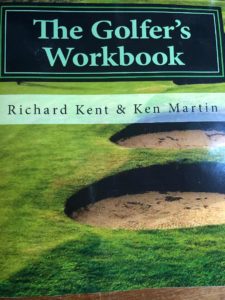– By Ken Martin PhD, Golf Specialist
The Value of Golf Notebooks and Journals
Elite athletes, including professional golfers like Jason Dufner and Maverick McNealy, use training logs, notebooks, and journals to analyze their performance. They realize writing is a powerful way to discover what we know—and don’t know—about whatever we are trying to learn. “If you are serious about your game and crave consistency” (Derek Deminsky, PGA), writing can help you to understand your game and plan for future outings. And, surprise, it’s neither complicated nor mysterious.
Here are a few ways writing can support performance and enjoyment in your game whether you’re working to break 80, or 90, or just starting out. Perhaps you simply want a more relaxed and satisfying round whatever the numbers add up to.
Play Better
Performance Records…Continuous improvement depends on reflection: a thoughtful review after each round or practice session. This reflection is more than sharing highlights with playing partners over a cold drink. Start by taking a few minutes right after a round to jot down high’s and low’s of the day. Focus on your best shots and what you learned about the course or your game. Think about how you handled different holes and different conditions. A spiral notebook, small enough to fit in your bag can work.
Later, replay your round through writing in a larger notebook. Copy your scores into a “playing record” and identify where you gained or lost strokes, expand your earlier notes, look for patterns, and describe them in writing. Finally, write down one or two action steps for your next time out on the practice range or course.
Journal Writing…Use writing to unpack problems and make plans ahead of time to attack those challenges when they arise on the course. Here are two suggestions:
- Losing focus is a common challenge. Standing over the ball, we start to wonder, “Is my grip right? Will the wind gust? What are my playing partners thinking?” Dr. Joe Parent (Zen Golf) calls these thoughts “anyways,” as in “I’m not focused or committed but I’ll go ahead and swing anyway.” Write about your anyways. What disrupts your concentration on the course? How can you overcome this interference and maintain your focus?
- In my book, The Golfer’s Workbook, with Richard Kent, we suggest two-column notes as a way to manage your game. Divide a journal page in half. On the left, list things you cannot control (e.g., the weather). On the right, list things you can control (e.g., your reaction to a mis-hit). Awareness can help you accept what you can’t control and manage what you can. Use two columns for other comparisons such as holes you play better or less well or traits in a playing partner you prefer or find annoying.
And Enjoy It More
We golfers often get wrapped up in results and forget the many other reasons we play this great game. Here are two ways to focus on the pure enjoyment of golf:
- Write about your favorites: favorite places to play, favorite playing partners, your favorite wood or iron. Describe them. Why are they special? What have you learned from them?
- Our brains naturally remember out-of-the-ordinary events, like that 8-iron over water to tap-in range of the pin. Unfortunately, we tend to emphasize missed opportunities and failed attempts more (the 8-iron we dunk). Write about your best moments in golf like the perfect pitch or brilliant strategy. Then, turn several of these “best moments” into a mental performance video, a highlight reel you can bring up whenever you want or need it.
#1 Tip for Writing…Just do it! Don’t worry over spelling, grammar, or complete sentences. Just write, for an audience of one: Yourself.
The Golfer’s Workbook by Richard Kent and Ken Martin (available on Amazon) includes a variety of activities, including a playing record for analyzing rounds and more than 75 easy-writing prompts that help golfers learn about their game.


